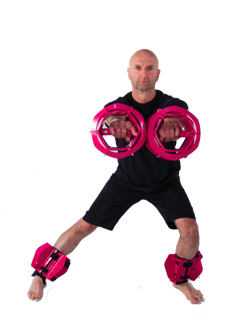Regardless of our age or fitness level, falling is something we are all at risk of. Thankfully, for many children and adults, falls do not result in a serious injury. However, unfortunately, the older population are at a much higher risk of falling and causing some damage.
As we grow older, we see a natural decline in muscle mass, bone density, strength, range of motion, poor posture, muscle imbalances and other key senses. These changes, can all attribute to an increased risk of falls resulting in injury. Identifying these risk factors can be a great start to help prevent unnecessary falls. According to the National Council on Aging, "Every 14 seconds, an older adult is treated in the emergency room for a fall; every 29 minutes, an older adult dies from a fall related injury." Sadly, falls are considered to be the main cause of death from injury in those 65 and older.
Aquatic exercise is a fantastic way to help the at-risk population improve their balance, mobility and flexibility in a safe and controlled environment, which in turn, can help reduce their overall risk of falling.
In addition to challenging core and balance, the water also helps increase blood flow and can reduce swelling causing chronic joint pain and stiffness. This, combined with waters buoyancy can help individuals perform particular movements, with more ease and comfort than they could on land. Viscosity also allows for increased time of response so that reaction time can be trained more functionally.
We asked Dr Rick McAvoy what top movements he would recommend for someone wanting to work on fall prevention: "In my experience one of the most challenging exercises for coordination is walking backwards. Trying to perform an unfamiliar pattern such as walking backwards requires so much motor planning. When walking in the water the arms and legs are moving at different speeds which adds to the difficulty. I find that backwards walking requires proper upright posture, good hip extension, trunk rotation and core stability as well."
- Start with doing a few laps of walking forwards to establish a good posture and reciprocal pattern.


- Then when the client is comfortable with walking forwards try backward walking with cueing for pattern and posture


- Once the client is comfortable, you can challenge coordination and balance further by using ONE fin on either leg or arm.
- The body moves in 3 planes of motion and the water is a unique and safe 3-dimensional environment. We want to challenge the client in all directions to improve balance, coordination, muscle balance and motor patterning.
- Now have your clients try the side lunge:
- Side step by bending at the hip and knee
- Push hands out while stepping at the same time
- Keep opposite leg straight
- Return hands towards chest, bringing legs together.



- As your clients confidence and skill levels build, you can have them practice single leg exercises such as a single leg push pull:
- Stand on one leg
- Keep a good upright posture
- Push / pull equally
- Keep core and buttocks engaged
- Repeat on opposite leg


Improving a clients range of motion and balance also goes a long way in restoring their confidence and helps ensure they don't have fear of performing every day tasks.





